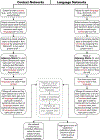Using Network Science to Map What Montréal Bilinguals Talk about Across Languages and Communicative Contexts
- PMID: 32905520
- PMCID: PMC7473004
- DOI: 10.1016/j.jneuroling.2020.100913
Using Network Science to Map What Montréal Bilinguals Talk about Across Languages and Communicative Contexts
Abstract
Recent work within the language sciences, particularly bilingualism, has sought new methods to evaluate and characterize how people differentially use language across different communicative contexts. These differences have thus far been linked to changes in cognitive control strategy, reading behavior, and brain organization. Here, we approach this issue using a novel application of Network Science to map the conversational topics that Montréal bilinguals discuss across communicative contexts (e.g., work, home, family, school, social), in their dominant vs. non-dominant language. Our results demonstrate that all communicative contexts display a unique pattern in which conversational topics are discussed, but only a few communicative contexts (work and social) display a unique pattern of how many languages are used to discuss particular topics. We also demonstrate that the dominant language has greater network size, strength, and density than the non-dominant language, suggesting that more topics are used in a wider variety of contexts in this language. Lastly, using community detection to thematically group the topics in each language, we find evidence of greater specificity in the non-dominant language than the dominant language. We contend that Network Science is a valuable tool for representing complex information, such as individual differences in bilingual language use, in a rich and granular manner, that may be used to better understand brain and behavior.
Keywords: bilingualism; cognitive control; conversational topics; individual differences; network analysis; network science.
Figures







Similar articles
-
Bilingual language entropy influences executive functions through functional connectivity and signal variability.Brain Lang. 2021 Nov;222:105026. doi: 10.1016/j.bandl.2021.105026. Epub 2021 Sep 28. Brain Lang. 2021. PMID: 34597903
-
Ecological Validity in Bilingualism Research and the Bilingual Advantage.Trends Cogn Sci. 2018 Dec;22(12):1117-1126. doi: 10.1016/j.tics.2018.10.001. Epub 2018 Oct 24. Trends Cogn Sci. 2018. PMID: 30449317 Review.
-
Activation Patterns throughout the Word Processing Network of L1-dominant Bilinguals Reflect Language Similarity and Language Decisions.J Cogn Neurosci. 2015 Nov;27(11):2197-214. doi: 10.1162/jocn_a_00853. Epub 2015 Jul 30. J Cogn Neurosci. 2015. PMID: 26226076
-
Functional separation of languages in the bilingual brain: a comparison of electrical stimulation language mapping in 25 bilingual patients and 117 monolingual control patients.J Neurosurg. 2004 Sep;101(3):449-57. doi: 10.3171/jns.2004.101.3.0449. J Neurosurg. 2004. PMID: 15352603
-
Cross-linguistic transfer in bilinguals reading in two alphabetic orthographies: The grain size accommodation hypothesis.Psychon Bull Rev. 2018 Feb;25(1):386-401. doi: 10.3758/s13423-017-1273-0. Psychon Bull Rev. 2018. PMID: 28405906 Review.
Cited by
-
Engaging proactive control: Influences of diverse language experiences using insights from machine learning.J Exp Psychol Gen. 2021 Mar;150(3):414-430. doi: 10.1037/xge0000933. Epub 2020 Oct 1. J Exp Psychol Gen. 2021. PMID: 33001688 Free PMC article.
-
Memory after visual search: Overlapping phonology, shared meaning, and bilingual experience influence what we remember.Brain Lang. 2021 Nov;222:105012. doi: 10.1016/j.bandl.2021.105012. Epub 2021 Aug 28. Brain Lang. 2021. PMID: 34464828 Free PMC article.
-
Moving From Bilingual Traits to States: Understanding Cognition and Language Processing Through Moment-to-Moment Variation.Neurobiol Lang (Camb). 2021 Nov 11;2(4):487-512. doi: 10.1162/nol_a_00046. eCollection 2021. Neurobiol Lang (Camb). 2021. PMID: 37214629 Free PMC article. Review.
-
Linguistic diversity shapes flexible speech perception in school age children.Sci Rep. 2024 Nov 21;14(1):28825. doi: 10.1038/s41598-024-80430-1. Sci Rep. 2024. PMID: 39572753 Free PMC article.
-
Open-access network science: Investigating phonological similarity networks based on the SUBTLEX-US lexicon.Behav Res Methods. 2025 Feb 18;57(3):96. doi: 10.3758/s13428-025-02610-9. Behav Res Methods. 2025. PMID: 39966206 Free PMC article.
References
-
- Abutalebi J, & Green DW (2016). Neuroimaging of language control in bilinguals: neural adaptation and reserve. Bilingualism: Language and Cognition, 19(4), 689–698. 10.1017/S1366728916000225 - DOI
-
- Anderson JA, Hawrylewicz K, & Bialystok E (2018a). Who is bilingual? Snapshots across the lifespan. Bilingualism: Language and Cognition, 1–12.
Grants and funding
LinkOut - more resources
Full Text Sources
